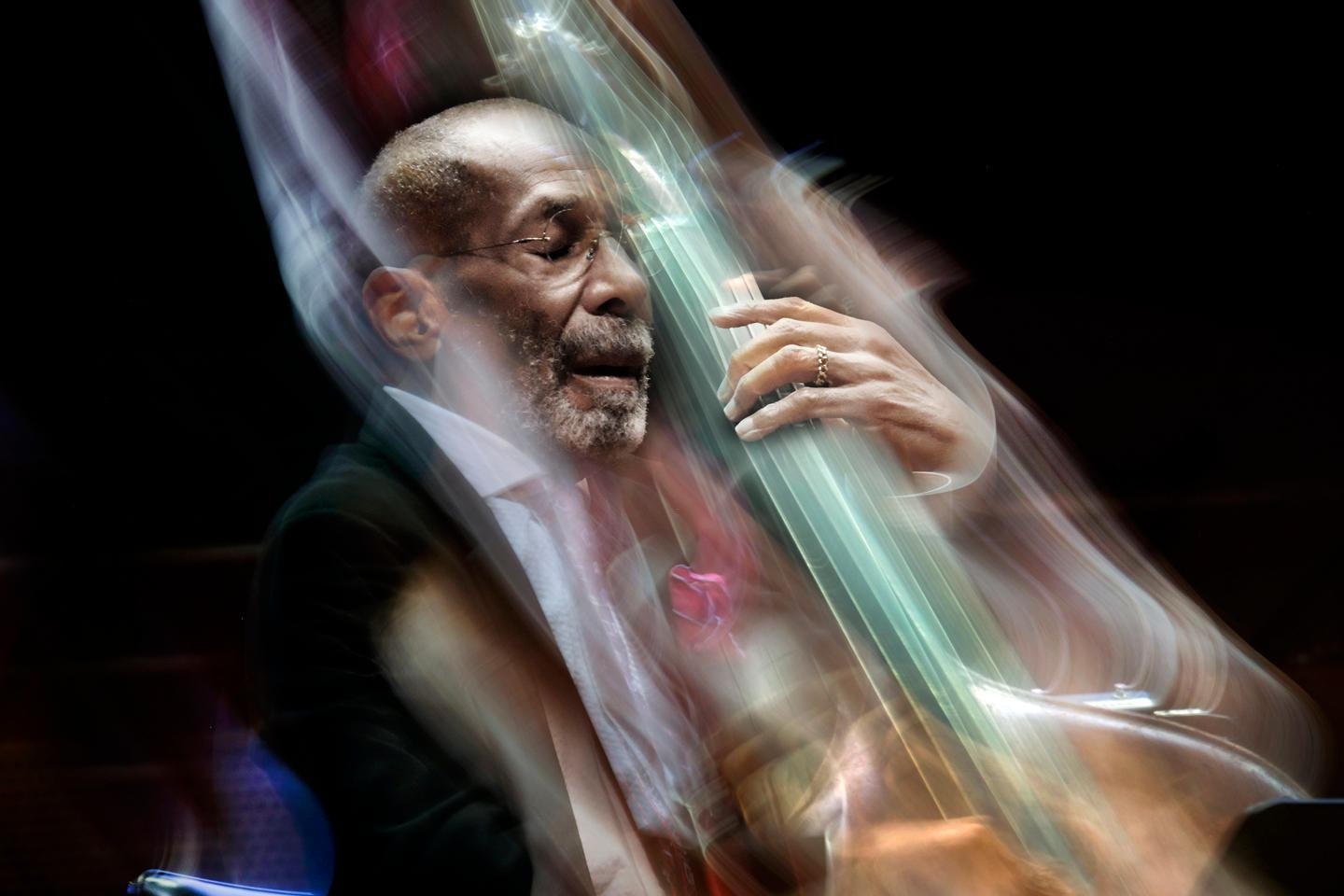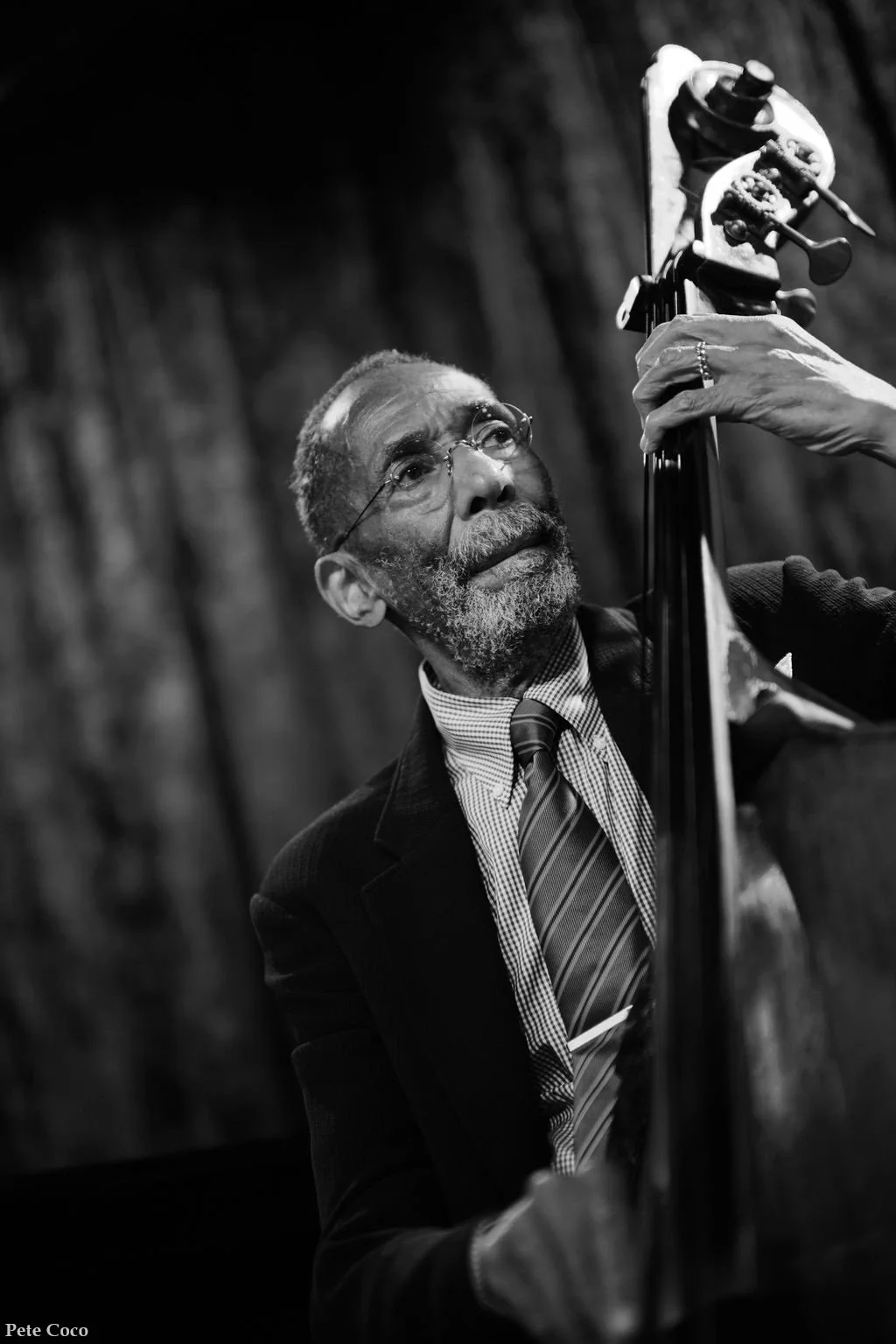Three Views of a Sound…Musings about Maestro
Bassists Larry Gray, Marlene Rosenberg, and Darius Savage discuss the magic made by the man they admire, Ron Carter
Photo of Maestro Ron Carter was taken and artistically enhanced by Lauren Deutsch
From whatever space your mind is in right now, this is…Jazz In (?) Jeopardy!
Our first contestant’s footprints are, most likely, still visible on whatever took the place of the stage at the former Jazz Showcase on South Balbo, where he played with Willie Pickens, Dorothy Donegan, Bunky Green, and 999,997 other cats! Please welcome Larry Gray!
Our second contestant’s Bassprint(s) have anchored ensembles at the South Shore Cultural Center and Winter’s, among many other places, and she has also led her own groups at the Green Mill and the Jazz Showcase on South Plymouth Court. Please welcome Marlene Rosenberg!
Our third contestant graduated from Fred Anderson University – also known as the Velvet Lounge – where he studied in sound with Vincent Davis, Ernest Dawkins, the namesake griot, and many other improvisers. A member of the Association for the Advancement of Creative Musicians (AACM), -- who also attended the University of Illinois-Champaign (U. of I.) so that he could, as he stated, “Get the hell out of Kankakee,” – please welcome Darius Savage!
And now, the dude who is finally getting around to dropping this hit nearly two years after interviewing these contestants, Corey Hall!
Hey, y’all! Welcome to the Occasion. Today’s focus is Maestro Ron Carter. As my August 15, 2023, JazzGram feature on “Mr. Bow Tie” began, “His lifetime accomplishments were enshrined in the Guinness World Records on January 7, 2016. As declared by writer Rachel Swatman, “With an incredible total of 2,221 individual recording credits as of 15 September 2015, legendary American musician Ronald Levin Carter aka Ron Carter (USA, b.1937) has certainly earned his…title as the Most recorded jazz bassist in history.”
Carter’s creativity continues to flow. On February 21, The Alpine Session: Arbenz vs. Arbenz Meets Ron Carter, debuted on Bandcamp. (Pianist Michael and drummer Florian Arbenz are twin brothers.) One day later, Maestro performed at The Nash, a performance space located in Phoenix, Arizona, with drummer Lewis Nash and pianist Donald Vega. Coming up, from April 29-May 4, his 88th birthday, the Blue Note New York will host his Foursight Quartet, which features pianist Renee Rosnes and saxophonist Jimmy Greene, and his New Jazz Trio, with saxophonist Donald Harrison.
So, let’s begin Jazz In (?) Jeopardy!
Round One: First Light, to honor Maestro’s contributions to Freddie Hubbard’s 1971 album which bears that name.
Call: “Carterisms.”
Response…from Larry Gray!
“That is the term I have used with my students for the past 30 years, when describing the nuances of Ron Carter’s playing,” said Gray, who has released four albums as a leader. (He can also get down on the electric guitar, cello, and accordion.)
When further explaining the term Carterisms, Gray first discussed bassist Jimmy Garrison’s communication with drummer Elvin Jones, when they played in John Coltrane’s quartet in the early to mid-60s. Garrison’s interplay with Jones, he explained, contained numerous nooks, crannies, and wide edges. However, as Jones’ rhythm partner on (former Coltrane) pianist McCoy Tyner’s albums – such as The Real McCoy (1967) and Trident (1975) – Carter infused his own voice, which contrasted with what Garrison had established with Jones.
“The word I use is ‘envelope.’ That envelope was different, and with Carter’s sound, the notes were longer,” said Gray, currently a full professor of Jazz Performance at the U. of I. “Carter was smoother. He had these triplets, these rhythmic fills. We used to call them pulses, things not so much defined as a note, but more like a rhythmic hit. The quarter notes were cleaner. A big part of Carter’s thing was rhythmic expansion.
“And when you hear Carter play on ‘Passion Dance,’ (from The Real McCoy), you hear how he makes Elvin sound really different from when he was playing with Garrison,” Gray continued. “It’s not better or worse, just different.”
(By the way, in 2021, Carter cut a video on Youtube where he described playing with Jones: “One of the things I remember most was…how he made the drums sound and the brushes sound so complete,” he said. “(Elvin had) so much motion without being busy and allowing me to try to find some nice notes to make that stuff work.”
As anyone who witnessed Jones in action knows, his profuse sweating could fill up the deepest ocean as his thunder reached the highest sky. Well, after one performance, Jones greeted Maestro in his own special way.
“It was one of those hot, sweaty nights,” Carter recalled. “And he gave me a big, fat embrace and ruined my nice tie! I never got over that!”)
Carter’s organic statements, in unison with Herbie Hancock’s and Tony Williams’ uncompromising energy in Miles’ Second Great Quintet, have always moved Gray. While listeners could view Carter as carrying on Paul Chambers’ legacy, the differences between him and his predecessor, Gray said, should be noted.
“Carter was different in terms of his sonic presence,” he explained. “He was different in terms of making more choices and doing more things with the different ways the music was moving.”
Gray then recalled a conversation he had about Maestro with saxophonist/composer Benny Golson. His question: “What’s it like playing with Ron Carter?”
“He looked at me, looked at the ceiling, and said, ‘Ron Carter. You never know what that guy’s going to do,’ ” Gray said. “People might not understand what that means. But what I heard was, ‘He’s into the music. I might expect a generic thing, but he’s always going to surprise me, and he’s going to have it all balanced.’”
Round Two: “Two Bass Hit,” to honor Mr. P.C., Maestro’s predecessor.
Call: Finding the Right Notes
Response… from Marlene Rosenberg
“I loved the book and documentary,” she said, referring to the autobiography and documentary chronicling Carter’s life, published and broadcast in 2008 and 2022, respectively/respectfully. Rosenberg, who has released four albums as a leader – including the aforementioned Bassprint and MLK Convergence – has performed with Bobby Watson, Bobbi Wilsyn, Benny Green, and goo gobs more!
In 1985, she received a National Endowment for the Arts Fellowship Grant to study with bassist Mike Richmond, pianists Hal Galper and Jim McNeeley, and Maestro Ron Carter.
“We worked a lot on clarity, tone, and consistency of the lengths of notes,” she said. “We worked on establishing a consistent and thoughtful way of playing the bass.”
Maestro’s instructions, she added, were measured and methodical. Points were made with very few words, and while she played, he would observe, listen, and correct.
“His lessons were expansive in expanding my vision and understanding of how to play in a group. He presented different ways of thinking about it,” Rosenberg said. “He taught me that there are different ways to respond to people around you, about playing different notes, and getting a different feel depending on what the music required.”
Rosenberg also noted how the strings on Maestro’s bass account for his iconic sound.
“They are black, nylon strings. They allow him to cut through when the band is playing,” she said. “His strings are more on the treble side of the equalization of sound and have this growl to them. And his feel is steady and grounded. It’s very different.”
Rosenberg then mentioned VSOP – the quintet with Freddie, Wayne Shorter, Herbie and Tony – and his 1977 album, Third Plane, a trio session with the latter two brothers, as exemplary recordings that are so Ron Carter.
When elaborating about Maestro’s clarity and hear-it-ability, she mentioned Sorcerer, Miles’ 1967 release, and Joe Henderson’s The State of the Tenor, Volumes One and Two. She singled out “Beatrice” as being amazing in its beauty. “Maestro plays all the double stops, and it outlines everything,” she said about the 1986 recording by “Joe Hen,” with whom she toured in the late ‘80s.
And let’s not forget The Bass and I, Carter’s 1997 gift that included pianist Stephen Scott, Nash, and percussionist Steve Kroon. Rosenberg really enjoyed how the gents interpreted “The Shadow of Your Smile.”
“Every chorus is a little bit different. It’s moving and growing. There are peaks and valleys. They climbed up the hill and brought it back down safely…or not safely. I don’t know!” she said, laughing. “This performance is quite beautiful.”
Rosenberg valued studying again with Maestro years later, until COVID came. She did, however, recall the joy she experienced when they studied Johann Sebastian Bach’s “toons.”
“It was very interesting in a different way, because he did not use a bow,” she said. “He would then quote Bach at a gig when he was playing an intro, and it was all beautiful.
“Maestro’s a very thoughtful and warm soul who’s not afraid to be who he is musically and personally,” she continued. “He looks great and takes good care of himself. He’s one of the great treasures in music.”
Round Three: Third Plane/Planet Elegance…to honor Maestro’s apparel line.
Call: His introduction to Ron Carter on Miles Smiles happened during a Jazz Appreciation class at the U. of I. in 1989.
Response…from Darius Savage!
“I had never heard anything like that musically, but not just Ron Carter,” said Savage, who played electric bass at the time. “It was Ron’s tone and the way he and Tony worked. And the interaction on ‘Footprints’ still blows my mind.”
Later, in his dorm room, Savage would lower the lights, light up the lava/love lamp, heat up some herb, and inhale the quintet’s smokin’ sessions.
“Listening to ‘Footprints’ was like listening to rain talk. It was like listening to the secret life of raindrops,” he recalled. “It was so intimate…
“And also ‘Mood’ (from E.S.P) Ron’s playing: Doom…doom…de doom…de doom,” Savage sang. “It was definitely not the bass I grew up learning how to play.”
Once Savage began playing upright bass in 1996, he further understood the instrument’s sound, not just its notes. And he also dug deeper into Maestro’s intensity.
“Ron Carter would play the whole bass. He was playing long slides all the way up the bass,” he said, laughing. “He was like: do-do-do-do-do-do-do-do-do-dewoooooooooooooong! And I’m like: What! Is! Happening?!
Miles’ Second Great Quintet, Savage continued, lives on today through the AACM’s Great Black Music Ensemble. “Miles said, ‘Here’s the framework. Go! Bring everything you know. Practice. Learn everything, and then get on stage and forget it all.’ That’s what we do,” said Savage, who has also performed with saxophonist David Boykin and flautist Nicole Mitchell.
Savage met Maestro in the early ‘90s after listening to him perform in Montreal with pianist Cedar Walton’s trio. He recalled being in absolute awe about Carter’s coolness, especially how, when he signed his autograph, it appeared as Retracnor.
Carter’s signature sound, he added, also incorporates rhythms from the African diaspora. When explaining this observation, Savage cited Carter’s “playing eighth notes and swinging, strumming the bass, tapping the sides of the bass, playing rhythms, and tapping the strings to make a different sound.
“All these are different sounds of other instruments that exist in other diasporas,” he said. “They cause a different feeling that creates a different narrative. Ron Carter’s playing has always told a story, and it’s a story no one else is telling.”





